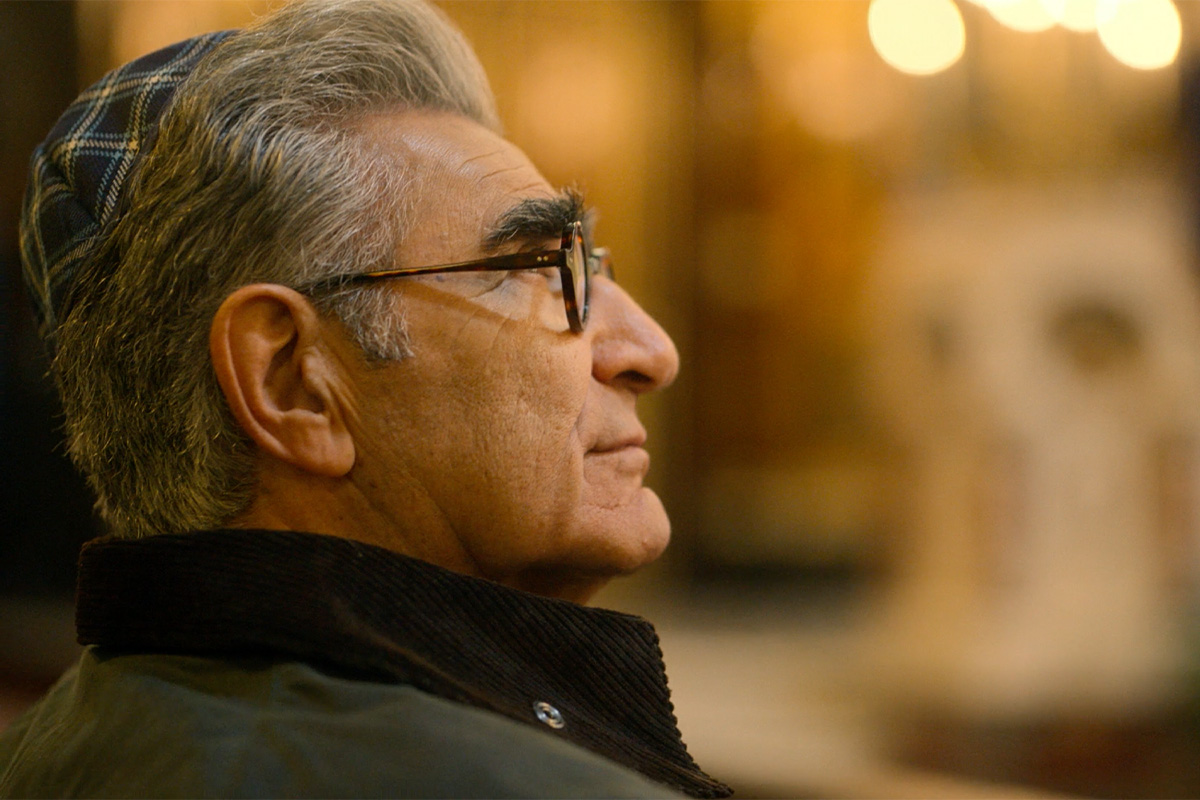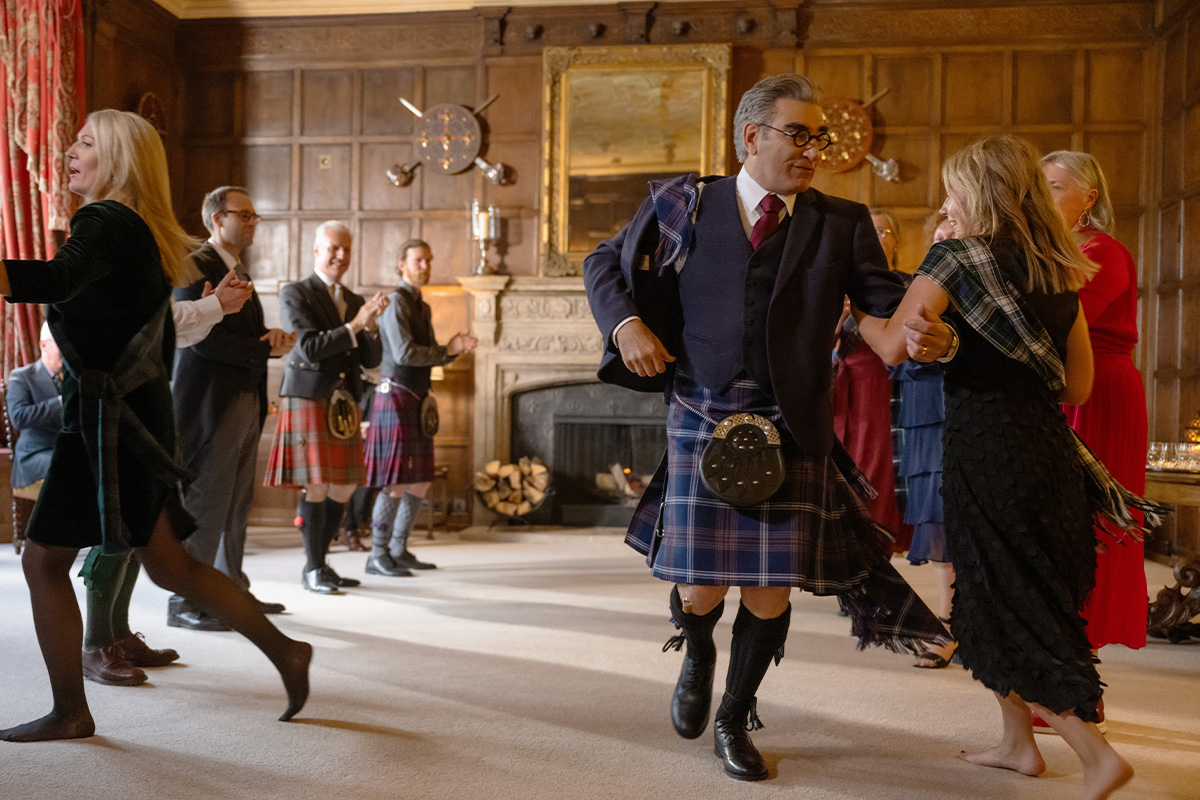When legendary Jewish comedian Eugene Levy premiered “The Reluctant Traveler” on Apple TV+ last year, I finally felt seen by a travel show. The premise is that Eugene is thrust outside of his comfort zone, traveling around the globe and participating in adventures he normally wouldn’t. In the first season, we saw him somewhat unwillingly ice fish in Finland, stay the night in the Costa Rican jungle, prepare for typhoon season in Tokyo and more, ultimately broadening his world outlook. It’s really the perfect show for a self-identified neurotic Jew like myself.
The second season drops on Apple TV+ today, and this time Eugene is reluctantly going on a European tour through Sweden, Scotland, France, Germany, Italy, Greece and Spain. And while we get more of Eugene trying things he wouldn’t normally and conquering his fears, this season will resonate with Jewish audiences for another reason: In the second episode, Eugene finds meaningful connection to his mother’s Scottish Jewish roots and — I swear I’m not joking — wears a kosher kilt.
In “Scotland: My Mother’s Country,” Eugene visits the Scottish Highlands and later Glasgow, where his mother was born and spent her childhood, for the very first time. The first stop is Candacraig House, a 17th-century estate nearby the British royal family’s Balmoral Castle and a far cry from his mother’s immigrant experience. Still, in the halls of this Gaelic landmark, Eugene arranges to meet with Michael Tobias, an expert of Scottish Jewry and their ancestry. Michael presents Eugene with a family tree and history of his mother Rebecca “Betty” Kudlatz, shows him never-before-seen photos of his great-grandparents Samuel and Nellie and tells him that they came to Glasgow in 1891 from a small Polish town called Nasielsk. Michael also explains that Eugene’s family moved to Scotland before moving on to Canada because they could only afford to make the trip in two sections.
“I’m actually proud that I, you know, had relatives who wanted a better life for their family. And to think what they had to go through at the time, you know, that’s pretty major stuff,” Eugene says to camera afterwards.
Then, it’s kilt time. On the drive from the Highlands to Glasgow, Eugene, nervously, makes a stop to meet with an artisan kilt-maker named Bill. “The key to a kilt is the tartan, and there are over 9,000 recorded patterns, nearly half of which symbolize a different family or clan,” Eugene explains in voice-over as Bill shows him various tartans. While Eugene is unsure if the Kudlatz clan had a specific tartan, Bill suggests he choose a tartan which he could connect with on a personal level. “What about this one? It’s known as the kosher tartan, and it’s a Jewish tartan,” Bill says, offering a gorgeous pattern with blue, white, red, gold and silver lines. (If you’re wondering, the tartan is literally kosher as it doesn’t mix wool and linen which is prohibited in the Torah.)
“Well, that sounds like it’s right on the nose, doesn’t it?” Eugene replies enthusiastically and with no pun intended. Bill then takes some measurements and gets to work on the kilt. In the meantime, Eugene makes his way to his mother’s hometown, the most profound part of the journey.
In Glasgow, Eugene’s first stop in the Gorbals, a working class, immigrant housing district where his mother grew up. But the emotional pinnacle of the episode is undoubtedly at the Garnethill synagogue. “It’s been awhile,” Eugene says, admitting he doesn’t regularly go to synagogue, before putting on a kippah and entering the sanctuary.

Here, in the golden and glowing temple, Eugene walks in his mother’s footsteps. The realization of this fact clearly touches him. He takes a seat in a pew, staring at the bimah, ark and eternal flame, and the background music swells. “Actually being here, a hundred years later, I’m feeling a bit of a, you know, tug,” he reveals.
“Do you think of her often?” a crew member asks. “Every day,” Eugene responds, softly. “My mum and my dad. There’s always one time in the day when, they just kind of, you know, come into mind.”
He adds, “I’ve never quite felt the attachment to where the family is from. It was only an attachment through stories. So I’m glad I came. I’m glad I’m here. And I’m glad I’m kind of reconnecting.”
The next morning, Eugene visits the cemetery where Samuel and Nellie are buried. He leaves stones on the graves of “two of the bravest people” he’ll never know, closing the family history portion of the trip both for the viewer and for himself.
But there’s one more important order of business: The episode simply has to end with the finished Jewish kilt. After a trip to a whisky distillery, Eugene returns to Candacraig House for “a wee Highland fling.” Wearing his kosher kilt, a kilt pin, sporran, kilt hose and shoes, Eugene does a high-energy Scottish dance with some of the people he’s met on his journey. Not only does he look at home in this symbol of the Scottish Jewish community, but frankly his moves are remarkably spry for a 76-year-old.
“I came to Scotland feeling like a stranger. But I leave here knowing that this country is part of whom I am. And I think my mum would be proud,” Eugene reflects at the end of the episode, perfectly capturing the Jewish experience of travel and diaspora.
The rest of the season is a delight as well. As Eugene continues to skeptically and hilariously broaden his horizons, there are a few more Jewish moments — Eugene referring to himself as Moses while herding 600 sheep down a narrow road in Germany is simply unmissable television. Though I found there were a couple missed opportunities, too. I would’ve loved for Eugene to connect with his paternal Sephardic heritage while in Andalusia. Nevertheless, Eugene’s poignant pilgrimage to Scotland is the highlight. It’s refreshing to see a veteran comedic actor like Eugene be open-hearted and moved by his own familial history. And it’s a reminder that perhaps one of Eugene Levy’s best roles is when he can earnestly play himself and embrace his Jewish identity.



